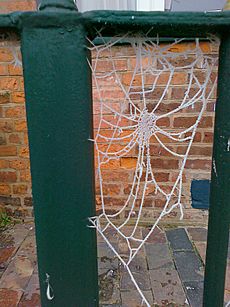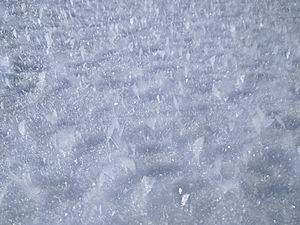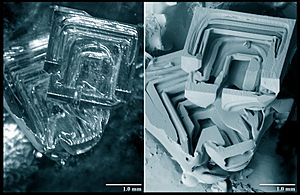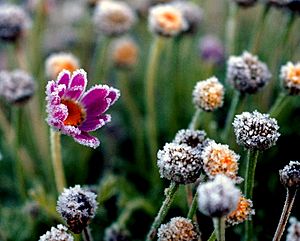Hoar frost facts for kids

Hoar frost, also hoarfrost, radiation frost, or pruina, refers to white ice crystals deposited on the ground or loosely attached to exposed objects, such as wires or leaves. They form on cold, clear nights when conditions are such that heat radiates into outer space faster than it can be replaced from nearby warm objects or brought in by the wind. Under suitable circumstances, objects cool to below the frost point of the surrounding air, well below the freezing point of water. Such freezing may be promoted by effects such as flood frost or frost pocket. These occur when ground-level radiation cools air until it flows downhill and accumulates in pockets of very cold air in valleys and hollows. Hoar frost may freeze in such low-lying cold air even when the air temperature a few feet above ground is well above freezing.
The word "hoar" comes from an Old English adjective that means "showing signs of old age". In this context, it refers to the frost that makes trees and bushes look like white hair.
Hoar frost may have different names depending on where it forms:
- Air hoar is a deposit of hoar frost on objects above the surface, such as tree branches, plant stems, and wires.
- Surface hoar refers to fern-like ice crystals directly deposited on snow, ice, or already frozen surfaces.
- Crevasse hoar consists of crystals that form in glacial crevasses where water vapour can accumulate under calm weather conditions.
- Depth hoar refers to faceted crystals that have slowly grown large within cavities beneath the surface of banks of dry snow. Depth hoar crystals grow continuously at the expense of neighbouring smaller crystals, so typically are visibly stepped and have faceted hollows.
When surface hoar covers sloping snowbanks, the layer of frost crystals may create an avalanche risk; when heavy layers of new snow cover the frosty surface, furry crystals standing out from the old snow hold off the falling flakes, forming a layer of voids that prevents the new snow layers from bonding strongly to the old snow beneath. Ideal conditions for hoarfrost to form on snow are cold, clear nights, with very light, cold air currents conveying humidity at the right rate for growth of frost crystals. Wind that is too strong or warm destroys the furry crystals, and thereby may permit a stronger bond between the old and new snow layers. However, if the winds are strong enough and cold enough to lay the crystals flat and dry, carpeting the snow with cold, loose crystals without removing or destroying them or letting them warm up and become sticky, then the frost interface between the snow layers may still present an avalanche danger, because the texture of the frost crystals differs from the snow texture, and the dry crystals will not stick to fresh snow. Such conditions still prevent a strong bond between the snow layers.
In very low temperatures where fluffy surface hoar crystals form without subsequently being covered with snow, strong winds may break them off, forming a dust of ice particles and blowing them over the surface. The ice dust then may form yukimarimo, as has been observed in parts of Antarctica, in a process similar to the formation of dust bunnies and similar structures.
Hoar frost and white frost also occur in man-made environments such as in freezers or industrial cold-storage facilities. If such cold spaces or the pipes serving them are not well insulated and are exposed to ambient humidity, the moisture will freeze instantly depending on the freezer temperature. The frost may coat pipes thickly, partly insulating them, but such inefficient insulation still is a source of heat loss.




